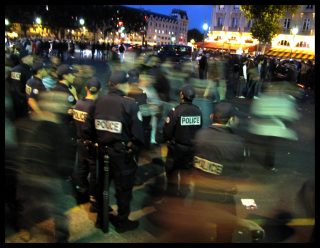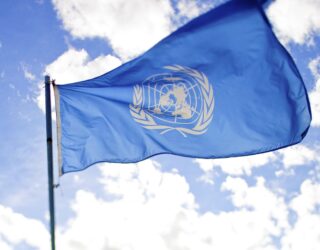Yet again public attention is focused on Muslim women, following France’s attempted bans of the burkini. Many see this item of swimwear, like the burka and the hijab, as part of Islamic tradition. But for older women who would have gone bare-headed in their teens, to wear the veil is an entirely new trend. They have seen how Muslim views on women’s clothing have varied throughout history and depending on changing political circumstances.
Banned in 15 towns across France, the burkini has been met by a chorus of indignation towards what many see as the enslavement of women. Wielding the French value of ‘laïcité’ or secularism, Prime Minister Manuel Valls has launched yet another nationalistic assault on Islam, calling the burkini an ‘archaic vision’ and ‘the impact of a political project, against society, and based mainly on the servitude of women.’ He is right that there are agendas behind Islamic dress today. But the political projects of Muslim women covering themselves are not the ones Valls imagines.
The French view that women can only be liberated through casting off the veil was once popular opinion across much of the Muslim world. An Egyptian jurist and feminist, Qasim Amin, wrote in the early 20th century that for women to attain the same status as men they should unveil themselves. This idea was perceived to be in keeping with Islam. An attempt to incorporate Western ways into Islamic practices, Amin’s writing gained popularity with the spread of education, influencing public thought in countries such as Syria, Jordan, and Iraq.
Other countries viewed the veil in a different light. In revolutionary Iran, for example, women wore the veil to resist the Shah, who opposed women’s political engagement. At first employed by a strong feminist movement to reject the male gaze, the veil later became compulsory under the repressive theocratic regime that took power post-revolution. So Iranian interpretations of the veil contrasted to those elsewhere. But the widespread belief in many places outside Iran, that to unveil implied freedom for women, meant that by the 50s many Muslim women chose not to cover themselves, electing to view the veil as an articulation of oppression.
Throughout the bloody years of colonialism, this imported belief became foreign intervention, as colonizers called upon all Muslim women to cast off the veil in a display of allegiance to the French state and to show a desire to engage in their civilizing mission. Once the symbol of ‘progress’ for Muslim countries, to unveil became associated with their scarring experiences of colonialism. One of the worst examples of the effect this had on native people can be seen in Algeria, where over half a million people were killed thanks to the ‘pacification’ methods of the French.
In resistance against colonialism, Muslim women re-covered themselves, reacting against the harshly imposed unveiling policy. Muslims of all genders in colonized countries challenged their persecutors by building a movement of political Islam against imperialism. One strand of this movement eventually became the Muslim Brotherhood, whose interpretation of political Islam is not necessarily oppressive towards women. On the contrary, many women became prominent members of the Muslim Brotherhood; for example, Zainab al – Ghazali, so crucial to the movement that she was thought of as their ‘unsung mother’. So it was in reaction against colonialism that the veil regained popularity, reappearing with even greater momentum following independence. By the 1990s the practice of women covering themselves began to spread to Muslims worldwide.
Since the colonial era, when colonists claimed to liberate women by unveiling them, the West has become obsessed with their unreconstructed idea of ‘protecting’ Muslim women from their male counterparts. In the aftermath of 9/11 this fascination peaked with a rescue mission proclaiming to save women from their oppressors, but deployed to justify the war in Afghanistan. First Lady Laura Bush demonstrated this via the following radio address: ‘Civilized people throughout the world are speaking out in horror – not only because our hearts break for the women and children of Afghanistan, but also because in Afghanistan we see the world the terrorists would like to impose on the rest of us… The fight against terrorism is also a fight for the rights and dignity of women.’ This apparent feminist concern was little more than a ploy to shore up domestic support for the War on Terror. As the British journalist Polly Toynbee put it, the image of the covered Muslim woman became the “battle flag” and “shorthand moral justification for the war in Afghanistan”. Contrary to expectations, this violent form of pity served only to encourage more women to take up the veil.
Where the Muslim brotherhood was ardently opposed to imperialism, today women’s own reasons for covering up are varied. An American Muslim woman and wearer of the hijab told Egyptian academic Leila Ahmed: “when people stare at me on the [Boston underground] I find myself thinking that if there’s just one woman out there who begins to wonder when she looks at me why she dresses the way she does and begins to notice the sexism in our society – if I’ve raised just one person’s consciousness, that’s good enough for me.” A convert to Islam told the professor that she wore the hijab to call for justice for minority groups, explaining, it is “a way of openly identifying with a group that people have prejudices about and as a way of saying, ‘yes we’re here, and we have the right to be here and to be treated equally.’’
A more recent series of interviews with Muslim women conducted by the BBC suggests that many women have now re-embraced ostensibly Western values like freedom of choice, associated with an idea of social progress. They perceive these to be in keeping with Islamic practices. “The burkini allows me the freedom to swim and go on the beach, and I don’t feel I am compromising my beliefs for that,” explained Aysha Ziauddin from Norfolk. “A big part of being in a modern society, part of living in freedom, is allowing people to live their life how they want to live it,” said Sabrina Akram who was raised in Pakistan but now lives in Massachusetts. For these women Islam is compatible with the liberal values they understand to be part of a ‘modern’ society.
As Manuel Valls unleashes his twisted version of laïcité against Muslim women’s ‘liberté’, so he causes Muslim women to be attacked right when they are attempting to integrate into French society. Valls might benefit from learning some Islamic history, to discover how Muslims’ interpretations of women’s clothing are not fixed and not necessarily oppressive as he presumes. But when Valls calls the burkini a ‘political project’ he isn’t totally wrong. The veil, readopted in the late 20th century, was part of a backlash against imperialism that gave rise to political Islam, and what we now know as Islamism. The changes in Muslim views of women’s clothing show how outsiders’ perspectives on Islam as sexist are helplessly obtuse. The French might say “ça brise le voile’ sur certains politicians de ‘gauche’,” or, “that breaks the veil”, meaning to reveal the truth, about certain ‘leftist’ politicians.
Image: esyckr



